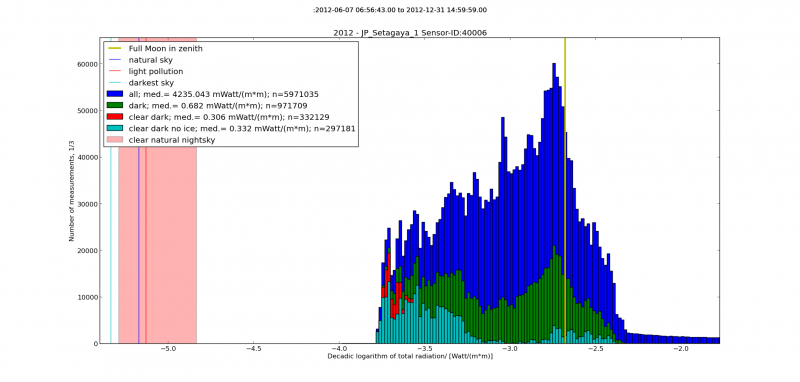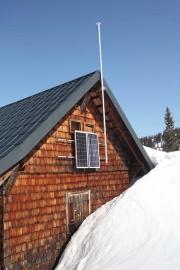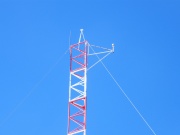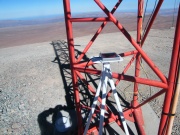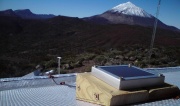Difference between revisions of "Hauptseite"
| (One intermediate revision by one user not shown) | |||
| Line 1: | Line 1: | ||
| − | + | __NOTOC__ | |
| − | |||
| + | == [[Starlight and Lightmeter Wiki:Portal]] == | ||
| − | ''' | + | == '''How many stars can we still see? - The starlight wiki''' == |
| + | [[File:JP Setagaya 1 Jun-Dec 2012 distribution.png|right|800px|Distribution of the total radiation - the light at night - in 2012 at the Setagaya - Tokyo Lightmeter station Details of the Setagaya station at the GAVO Lightmeter data-centre. The distribution of the decadic logarithm of total radiation in Watt per squaere meter W/m² is are shown as measured from June to December 2012 (courtesy Nobuaki Ochi and the Setagaya station.]] | ||
| − | + | [[File:Legenstein-Lighteter Maerz 2012 IMG 9142 viertel.JPG|thumb]] | |
| + | [[File:Armazones Lightmter on 30mtower.JPG|thumb]] [[File:Armazones Lightmeter preinstall.JPG|thumb]] | ||
| + | [[File:Lightmeter Teide observatory.jpeg|thumb]] | ||
| − | + | [[File:L26 Paranal Lux und 100s sigma 20 bis 28Juli2009 grob tageskalibiert.png|thumb]] | |
| − | + | [[File:Juni2009 Linz Wien Berlin Tautenburg.png|thumb]] | |
| − | + | [[File:Juni 12bis17 2009 Berlin Tautenburg.png|thumb]] | |
| − | + | [[File:L14 Berlin Feb Mae 2009.png|thumb]] | |
| − | + | ||
| − | *[ | + | [[File:L12 TLS 26Sep bis 7Nov2008.png|thumb]] |
| − | *[[[// | + | |
| + | '''[[Lightmeter]]:''' A network of newly-developed, low-cost lightmeters starts the global continuous monitoring of artificial night sky brightening (light pollution). Jan. 2013: >300 Lightmeters. [[Lightmeter|'''more''']] | ||
| + | |||
| + | '''May 3rd:''' Mediawiki update to Version 1.22.2 completed on May 3rd; GW --[[Benutzer:NorbertHerz|NorbertHerz]] ([[Benutzer Diskussion:NorbertHerz|Diskussion]]) 22:08, 3. Mai 2014 (CEST). --[[Benutzer:Nero2401|Nero2401]] ([[Benutzer Diskussion:Nero2401|Diskussion]]) 22:35, 3. Mai 2014 (CEST) | ||
| + | |||
| + | '''Apr. 14th, 2014:''' Vienna's lightdome shows 10% increase 2013, the 3rd year of network-monitoring [http://wua-wien.at/home/publikationen/3%7C <b>Licht über Wien III (Vienna Environmental Protection Agency)</b>], [http://www.wua-wien.at/home/administrator/components/com_astatspro/getfile.php?id=153 (pdf, 3MB)] | ||
| + | |||
| + | '''Sep. 26th 2013:''' Gabriel Stoekle (GAVO) announces the ''easy-Lightmeter'', a Rasberry PI data logger for the Lightmeter that automatically records and transfers data to the GAVO-database, [http://licht.sternhell.at/ http://licht.sternhell.at/] - the software should be released in a couple of months. | ||
| + | |||
| + | '''June 11th 2013:''' Report on one year of monitoring with the Vienna Lightmeter Network [http://wua-wien.at/home/naturschutz-und-stadt-kologie/lichtverschmutzung/lichtkataster-2012 Licht über Wien II: Wiener Lichtbericht 2012] online at the Wiener Umweltanwaltschaft (Vienna Environmental Protection Agency). | ||
| + | |||
| + | '''Jan. 12th 2013:''' First results from the new SETAGAYA (Tokyo) station as presented at a star party on 11 Jan. at the Setagaya Planetarium. From June to December 2012 the light at night 8 km from the centre of Tokyo scatters around the maximum full-moon values but some hours during the year are 15 times darker than the full moon - still about 10 times above natural light at night. --[[Benutzer:GuentherWuchterl|GuentherWuchterl]] 17:03, 14. Jan. 2013 (UTC) | ||
| + | |||
| + | '''Sep. 20th 2012:''', 8 UTC first light for the southernmost Lightmeter (47° S) at Mt. John Observatory, Lake Tekapo in the Lake Tekapo - Aoraki - Mount Cook Starlight Reserve, New Zealand, [http://starlightreserve.org http://starlightreserve.org] (IDA gold [http://www.darksky.org/page/IDSReserves http://www.darksky.org/page/IDSReserves] ). | ||
| + | |||
| + | <br/>'''Apr. 27th 2012:''', Light over Vienna - a study of the energy content of Vienna's light-dome and the top light emitters (in german): [http://www.wua-wien.at/home/administrator/components/com_astatspro/getfile.php?id=121 Download pdf from WUA] at the Vienna enviromental protection agency [http://wua-wien.at/ WUA], [http://wua-wien.at/ http://wua-wien.at/] | ||
| + | |||
| + | <br/>'''[[How many stars can we still see?]]:''' Simple naked eye sightings of the Little Dipper or Orion serve to determine the quality of the world's night skies. [[How many stars can we still see?|'''more''']] | ||
| + | |||
| + | |||
| + | |||
| + | *[http://amper.ped.muni.cz/light/lp_what_is.pdf <i>What is Light Pollution?</i> by Jan Hollan] | ||
| + | *[[La Palma Deklaration]] und Nacht/Sternschutzgebiete (Starlight-Reserve) | ||
| + | |||
| + | == [[Aktuell|News]] == | ||
| + | |||
| + | == Related == | ||
| + | |||
| + | [http://amper.ped.muni.cz/weather/ PV light measurement at twilight and night, Brno Observatory] | ||
| + | |||
| + | == Österreich-Seiten: == | ||
| + | |||
| + | *[[Beobachten]] | ||
| + | *[[Nachthimmelsschutz - LichtVerschmutzung]] | ||
| + | *[[Wieviele Sterne sehen wir noch? - 2009]] | ||
| + | *[[Wieviele Sterne sehen wir noch? - Ergebnisse 2009]] | ||
Revision as of 22:35, 3 May 2014
Starlight and Lightmeter Wiki:Portal
How many stars can we still see? - The starlight wiki
Lightmeter: A network of newly-developed, low-cost lightmeters starts the global continuous monitoring of artificial night sky brightening (light pollution). Jan. 2013: >300 Lightmeters. more
May 3rd: Mediawiki update to Version 1.22.2 completed on May 3rd; GW --NorbertHerz (Diskussion) 22:08, 3. Mai 2014 (CEST). --Nero2401 (Diskussion) 22:35, 3. Mai 2014 (CEST)
Apr. 14th, 2014: Vienna's lightdome shows 10% increase 2013, the 3rd year of network-monitoring Licht über Wien III (Vienna Environmental Protection Agency), (pdf, 3MB)
Sep. 26th 2013: Gabriel Stoekle (GAVO) announces the easy-Lightmeter, a Rasberry PI data logger for the Lightmeter that automatically records and transfers data to the GAVO-database, http://licht.sternhell.at/ - the software should be released in a couple of months.
June 11th 2013: Report on one year of monitoring with the Vienna Lightmeter Network Licht über Wien II: Wiener Lichtbericht 2012 online at the Wiener Umweltanwaltschaft (Vienna Environmental Protection Agency).
Jan. 12th 2013: First results from the new SETAGAYA (Tokyo) station as presented at a star party on 11 Jan. at the Setagaya Planetarium. From June to December 2012 the light at night 8 km from the centre of Tokyo scatters around the maximum full-moon values but some hours during the year are 15 times darker than the full moon - still about 10 times above natural light at night. --GuentherWuchterl 17:03, 14. Jan. 2013 (UTC)
Sep. 20th 2012:, 8 UTC first light for the southernmost Lightmeter (47° S) at Mt. John Observatory, Lake Tekapo in the Lake Tekapo - Aoraki - Mount Cook Starlight Reserve, New Zealand, http://starlightreserve.org (IDA gold http://www.darksky.org/page/IDSReserves ).
Apr. 27th 2012:, Light over Vienna - a study of the energy content of Vienna's light-dome and the top light emitters (in german): Download pdf from WUA at the Vienna enviromental protection agency WUA, http://wua-wien.at/
How many stars can we still see?: Simple naked eye sightings of the Little Dipper or Orion serve to determine the quality of the world's night skies. more
- What is Light Pollution? by Jan Hollan
- La Palma Deklaration und Nacht/Sternschutzgebiete (Starlight-Reserve)
News
Related
PV light measurement at twilight and night, Brno Observatory
